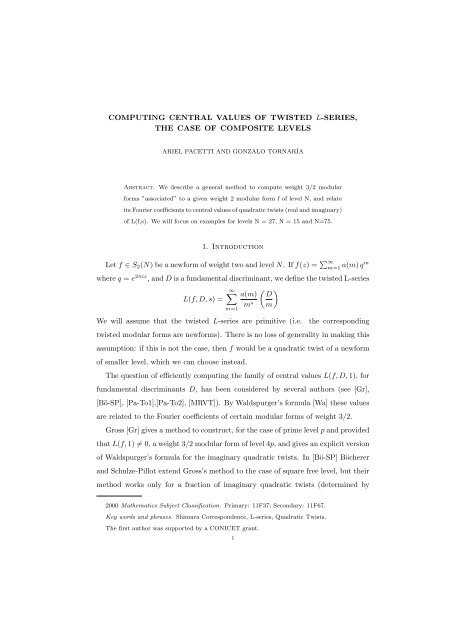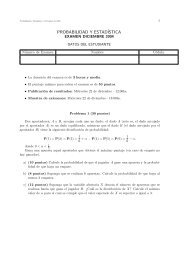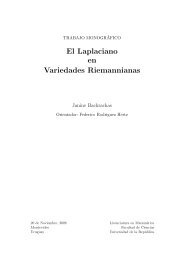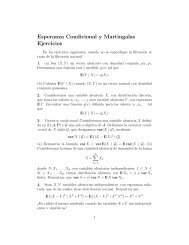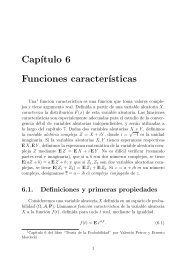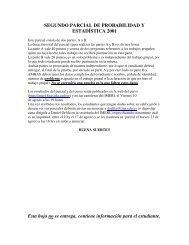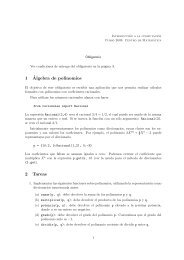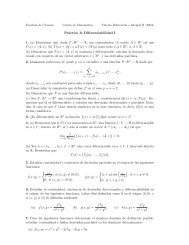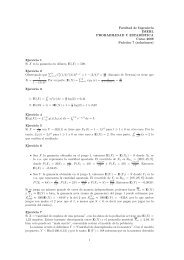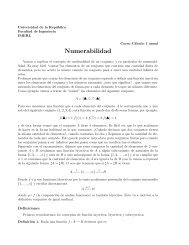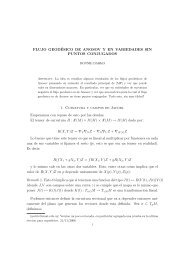COMPUTING CENTRAL VALUES OF TWISTED L-SERIES, THE ...
COMPUTING CENTRAL VALUES OF TWISTED L-SERIES, THE ...
COMPUTING CENTRAL VALUES OF TWISTED L-SERIES, THE ...
Create successful ePaper yourself
Turn your PDF publications into a flip-book with our unique Google optimized e-Paper software.
<strong>COMPUTING</strong> <strong>CENTRAL</strong> <strong>VALUES</strong> <strong>OF</strong> <strong>TWISTED</strong> L-<strong>SERIES</strong>,<strong>THE</strong> CASE <strong>OF</strong> COMPOSITE LEVELSARIEL PACETTI AND GONZALO TORNARÍAAbstract. We describe a general method to compute weight 3/2 modularforms ”associated” to a given weight 2 modular form f of level N, and relateits Fourier coefficients to central values of quadratic twists (real and imaginary)of L(f,s). We will focus on examples for levels N = 27, N = 15 and N=75.1. IntroductionLet f ∈ S 2 (N) be a newform of weight two and level N. If f(z) = ∑ ∞m=1a(m) qmwhere q = e 2πiz , and D is a fundamental discriminant, we define the twisted L-series∞∑( )a(m) DL(f, D, s) =m s mm=1We will assume that the twisted L-series are primitive (i.e.the correspondingtwisted modular forms are newforms). There is no loss of generality in making thisassumption: if this is not the case, then f would be a quadratic twist of a newformof smaller level, which we can choose instead.The question of efficiently computing the family of central values L(f, D, 1), forfundamental discriminants D, has been considered by several authors (see [Gr],[Bö-SP], [Pa-To1],[Pa-To2], [MRVT]). By Waldspurger’s formula [Wa] these valuesare related to the Fourier coefficients of certain modular forms of weight 3/2.Gross [Gr] gives a method to construct, for the case of prime level p and providedthat L(f, 1) ≠ 0, a weight 3/2 modular form of level 4p, and gives an explicit versionof Waldspurger’s formula for the imaginary quadratic twists. In [Bö-SP] Böchererand Schulze-Pillot extend Gross’s method to the case of square free level, but theirmethod works only for a fraction of imaginary quadratic twists (determined by2000 Mathematics Subject Classification. Primary: 11F37; Secondary: 11F67.Key words and phrases. Shimura Correspondence, L-series, Quadratic Twists.The first author was supported by a CONICET grant.1
2 ARIEL PACETTI AND GONZALO TORNARÍAquadratic residue conditions). Later in [Pa-To1] the case of level p 2 (p a prime)is considered, and this is used in [Pa-To2], provided p ≡ 3 (mod 4), to computecentral values for real quadratic twists.In [MRVT] the non-vanishing condition is removed, and in the case of primelevel two modular forms of weight 3/2 (one giving the imaginary quadratic twistsand another one giving the real quadratic twists) are constructed.The aim of this paper is to show how some of these ideas can be combined tohandle the case of composite levels. In the case of odd squarefree level N, forinstance, this method constructs 2 t modular forms, where t is the number of primefactors of N, whose coefficients give the central values of all the quadratic twists.We will focus on examples for levels N = 27, N = 15, and N = 75, which exhibitour methods for the non-square case. For the square case see [Pa-To1] and [Pa-To2].2. The curve 27ALet f be the modular form of level 27, corresponding to the elliptic curve X 0 (27),of minimal equation (see [Cr])y 2 + y = x 3 − 7 .The eigenvalue of f for the Atkin-Lehner involution W 27 is −1, and the sign of thefunctional equation for L(f, s) is +1.Let B = (−1, −3) be the quaternion algebra ramified at 3 and ∞, and considerthe order R = 〈 1, 3i, 1+3j 〉2, i+k2 , a Pizer order of reduced discriminant 27 (see [Pi]for the basic definitions of quaternion algebras, Brandt matrices and special orders).The class number of left R-ideals for such order is 2, and representatives for leftR-ideals are {R, I} where I = 〈 4, 12i, 7+6i+3j 〉2, 6+13i+k2 . The eigenvector for theBrandt matrices which corresponds to f is (1, −1), with height 3.The ternary quadratic forms associated to their right orders areQ 1 (x, y, z) = 4x 2 + 27y 2 + 28z 2 − 4xz ,andrespectively.Q 2 (x, y, z) = 7x 2 + 16y 2 + 31z 2 + 16yz + 2xz + 4xy ,
<strong>COMPUTING</strong> <strong>CENTRAL</strong> <strong>VALUES</strong> <strong>OF</strong> <strong>TWISTED</strong> L-<strong>SERIES</strong> 3D c(D) L(f, D, 1) D c(D) L(f, D, 1) D c(D) L(f, D, 1)-4 1 1.529954 -67 -1 0.373827 -139 3 2.335842-7 -1 1.156537 -79 1 0.344267 -148 1 0.251523-19 -1 0.701991 -88 -2 1.304749 -151 -1 0.249012-31 0 0.000000 -91 1 0.320766 -163 -1 0.239670-40 -2 1.935256 -103 1 0.301502 -184 2 0.902318-43 2 1.866526 -115 -2 1.141352 -187 -2 0.895051-52 1 0.424333 -127 -2 1.086092 -199 -3 1.952200-55 2 1.650392 -136 2 1.049540Table 1. Coefficients of g and imaginary quadratic twists of 27ANote that, since the twist of f by the quadratic character of conductor 3 is fitself, we haveL(f, −3D, s) = L(f, D, s) ,for −3D a fundamental discriminant. We will thus assume that 3 ∤ D.2.1. Imaginary quadratic twists. Let D < 0 be a fundamental discriminant. If( D)3 = +1, the sign of the functional equation for L(f, D, s) is −1, so its centralvalue vanishes trivially. Hence we can restrict to the case where ( )D3 = −1. In thiscase we can follow Gross’s method, using classical theta seriesΘ(Q i ) := 1 ∑q Qi(x,y,z) ;2(x,y,z)∈Z 3we obtain a weight 3/2 modular form of level 4 · 27, namelyg = Θ(Q 1 ) − Θ(Q 2 ) = q 4 − q 7 − q 19 + q 28 − 2q 40 + 2q 43 + · · · .Table 1 shows the values of the Fourier coefficients c(D) of g and of L(f, D, 1),where −200 < D < 0 is a fundamental discriminant such that ( )D3 = −1. TheGross type formulaL(f, D, 1) = k |c(D)|2 √|D|, D < 0 ,is satisfied, where c(D) is the |D|-th Fourier coefficient of g, andk = 1 3 ·(f, f)= 2L(f, −4, 1) ≈ 3.059908074114385749826388345 .L(f, 1)
4 ARIEL PACETTI AND GONZALO TORNARÍA2.2. Real quadratic twists. Let D > 0 be a fundamental discriminant. In thiscase, if ( )D3 = −1 the sign of the functional equation for L(f, D, s) will be −1,and its central value will vanish trivially. For ( )D3 = +1, we will employ a methodsimilar to the one used in [MRVT] for prime levels. We need to choose an auxiliaryprime l ≡ 3 (mod 4) such that ( )−l3 = −1 and such that L(f, −l, 1) ≠ 0, forexample l = 7. Following [MRVT] we define a generalized theta seriesΘ −7 (Q i ) := 1 2∑ω (i)7(x,y,z)∈Z 3(x, y, z) ω(i) 3 (x, y, z) qQ i(x,y,z)/7 ,where ω 7 and ω 3 are the two kinds of weight function introduced in §2.2 and §2.3 of[MRVT], respectively. The superscript in ω (i)3 and ω (i)7 indicates that we are writingthe weight functions in the basis corresponding to the quadratic form Q i .andThe weight function of the first kind can be computed as0 if 7 ∤ Q⎧⎪ 1 (x, y, z),⎨7 (x, y, z) = ( x)7if 7 ∤ x,⎪ ⎩ )otherwise;ω (1)ω (2)( 5z70 if 7 ∤ Q⎧⎪ 2 (x, y, z),⎨7 (x, y, z) = ( 3y+5z)7if 7 ∤ 3y + 5z,⎪ ⎩ )otherwise.( 6x7The weight function of the second kind can be computed as( )( )ω (1)x + z3 (x, y, z) = , and ω (2)2x + y + 2z33(x, y, z) = .3The generalized theta series will beΘ −7 (Q 1 ) = −2q 4 + 2q 13 + 4q 16 − 4q 25 + 2q 28 − 2q 37 − 4q 40 + · · · ,andΘ −7 (Q 2 ) = q − q 4 − q 13 + 2q 16 − 3q 25 − q 28 + q 37 + 2q 40 + · · · .Note that Θ −7 (Q 1 ) + 2Θ −7 (Q 2 ) = 2q − 4q 4 + 8q 16 − 10q 25 + · · · , corresponding tothe Eisenstein eigenvector for the Brandt matrices, has nonzero Fourier coefficientsonly at square indices. Since Θ −7 (Q 1 )+2Θ −7 (Q 2 ) ≡ Θ −7 (Q 1 )−Θ −7 (Q 2 ) (mod 3),this explains the fact that the coefficients in Table 2, with the exception of c −7 (1),are all divisible by 3.
<strong>COMPUTING</strong> <strong>CENTRAL</strong> <strong>VALUES</strong> <strong>OF</strong> <strong>TWISTED</strong> L-<strong>SERIES</strong> 5D c −7 (D) L(f, D, 1) D c −7 (D) L(f, D, 1) D c −7 (D) L(f, D, 1)1 1 0.588880 76 -3 0.607942 136 6 1.81785613 -3 1.469932 85 0 0.000000 145 6 1.76053628 -3 1.001590 88 -6 2.259892 157 6 1.69191737 3 0.871301 97 -3 0.538125 172 0 0.00000040 6 3.351961 109 0 0.000000 181 -9 3.54545761 3 0.678585 124 6 1.903786 184 -6 1.56286073 -3 0.620308 133 -3 0.459561 193 3 0.381496Table 2. Coefficients of g −7 and real quadratic twists of 27AThus we obtain a modular form of weight 3/2, namelyg −7 = Θ −7 (Q 1 ) − Θ −7 (Q 2 ) = q + q 4 − 3q 13 − 2q 16 + q 25 − 3q 28 + 3q 37 + 6q 40 + · · · ,and the formula is nowL(f, D, 1) = k −7|c −7 (D)| 2√|D|, D > 0 ,where c −7 (D) is the D-th Fourier coefficient of g −7 , andk −7 = 1 3 · (f, f)L(f, −7, 1) √ = L(f, 1) ≈ 0.5888795834284833191045631668 .7Table 2 shows the values of the Fourier coefficients c −7 (D) of g −7 and of L(f, D, 1),where 0 < D < 200 is a fundamental discriminant such that ( )D3 = 1.3. The curve 15ALet f be the modular form of level 15, corresponding to the elliptic curve X 0 (15),of minimal equationy 2 + xy + y = x 3 + x 2 − 10x − 10 .The eigenvalues of f for the Atkin-Lehner involutions W 3 and W 5 are +1 and −1,and the sign of the functional equation for L(f, s) is +1.The method of Gross, as extended by Böcherer and Schulze-Pillot to the case ofsquare-free levels, requires that the ramification of the quaternion algebra agreeswith the Atkin-Lehner eigenvalues. In this case, it would be necessary to work
6 ARIEL PACETTI AND GONZALO TORNARÍAwith the quaternion algebra ramified at 5 and ∞. To exhibit the generality of ourmethod, we will work with the quaternion algebra ramified at 3 and ∞ instead.Let B = (−1, −3) be such a quaternion algebra; an Eichler order of level 15〈〉(index 5 in a maximal order) is given by R = 1, i, 1+5j2, 1+i+3j+k2. The numberof clases of left R-ideals is 2, and a set of representatives of the classes is given〈〉by {R, I} where I = 2, 2i, 3+2i+5j2, 3+i+3j+k2. The eigenvector for the Brandtmatrices corresponding to f is (1, −1), with height 4, and the ternary quadraticforms associated to R and I areQ 1 (x, y, z) = Q 2 (x, y, z) = 4x 2 + 15y 2 + 16z 2 − 4xz .3.1. Imaginary quadratic twists. Let D < 0 be a fundamental discriminant.We say that D is of type (s 1 , s 2 ) if ( )D3 = s1 and ( )D5 = s2 . We need the sign ofthe functional equation for L(f, D, s) to be +1, so that its central value does notvanish trivially. For this to hold we need D to be of type (−, +), (+, −), (+, 0),(0, −), or (0, 0) (see [At-Le]).Note that the linear combination of classical theta series Θ(Q 1 ) − Θ(Q 2 ) is triviallyzero, since Q 1 = Q 2 ; this reflects the fact that the ramification does not matchthe Atkin-Lehner eigenvalues. Instead we setΘ 1 (Q i ) := 1 4∑ω (i)3(x,y,z)∈Z 3(x, y, z) ω(i) 5 (x, y, z) qQ i(x,y,z) ,where ω 3 and ω 5 are weight functions of the second kind as in [MRVT, §2.3]. Wehave Θ 1 (Q 1 ) = −Θ 1 (Q 2 ), and hence we obtain a modular form of weight 3/2 andlevel 4 · 15 2 , namelyg 1 = 2 Θ 1 (Q 1 ) = q 4 + q 16 + 2q 19 + 2q 31 + q 64 + · · · .The corresponding formula isL(f, D, 1) = k 1|c 1 (D)| 2√|D|, D < 0 of type (−, +),where c 1 (D) is the |D|-th Fourier coefficient of g 1 , andk 1 = 1 4 ·c.f. Table 3 (top).(f, f)= 2L(f, −4, 1) ≈ 3.192484444263567020297938143 ,L(f, 1)
<strong>COMPUTING</strong> <strong>CENTRAL</strong> <strong>VALUES</strong> <strong>OF</strong> <strong>TWISTED</strong> L-<strong>SERIES</strong> 7D c 1 (D) L(f, D, 1) D c 1 (D) L(f, D, 1) D c 1 (D) L(f, D, 1)-4 1 1.596242 -91 -4 5.354613 -184 -4 3.765649-19 2 2.929625 -136 -4 4.380053 -199 -2 0.905237-31 2 2.293549 -139 -2 1.083132-79 -2 1.436730 -151 2 1.039203D c 17 (D) L(f, D, 1) D c 17 (D) L(f, D, 1) D c 17 (D) L(f, D, 1)-3 2 0.921591 -83 4 0.350421 -152 8 1.035779-8 -4 1.128714 -87 4 0.684541 -155 8 2.051412-15 -2 0.824296 -95 0 0.000000 -167 4 0.247042-20 4 1.427722 -107 4 0.308629 -168 8 1.970444-23 4 0.665679 -120 -4 1.165730 -183 0 0.000000-35 -4 1.079257 -123 -4 0.575713 -195 -4 0.914474-47 -4 0.465672 -132 -8 2.222961-68 0 0.000000 -143 -8 1.067876Table 3. Coefficients of g 1 and g 17 , and imaginary twists of 15ATo obtain the other 4 types of negative D, we need to choose an auxiliary primel ≡ 1 (mod 4) such that ( l3)=( l5)= −1, and such that L(f, l, 1) ≠ 0, e.g. l = 17.We then define the generalized theta seriesΘ 17 (Q i ) := 1 4∑(x,y,z)∈Z 3 ω (i)17 (x, y, z) qQ i(x,y,z)/17 ,where ω 17 is the weight function of the first kind defined in [MRVT, §2.2]. Nowg 17 = 2 Θ 17 (Q 1 ) = 2q 3 − 4q 8 − 2q 15 + 4q 20 + 4q 23 + · · ·is a weight 3/2 modular form of level 4 · 15. As expected by the multiplicity onetheorem of Kohnen [Ko], this form turns out to be the same as the one constructedby Böcherer and Schulze-Pillot. The formula in this case isL(f, D, 1) = ⋆ k 17|c 17 (D)| 2√|D|, D < 0 of type (+, −), (+, 0), (0, −), or (0, 0) ,and ⋆ = 1, 2, 2, or 4 respectively; where c 17 (D) is the |D|-th Fourier coefficient ofg 17 , andk 17 = 1 4 ·(f, f)L(f, 17, 1) √ 17 ≈ 0.1995302777664729387686211340 ,
8 ARIEL PACETTI AND GONZALO TORNARÍAD c −19 (D) L(f, D, 1) D c −19 (D) L(f, D, 1) D c −19 (D) L(f, D, 1)1 2 0.350151 76 -16 2.570563 141 -8 0.94361621 -8 2.445093 109 16 2.146455 156 16 3.58841624 8 2.287175 124 16 2.012446 181 0 0.00000061 16 2.869261 129 -8 0.986530 184 -16 1.65206169 -8 1.348902 136 0 0.000000D c −23 (D) L(f, D, 1) D c −23 (D) L(f, D, 1) D c −23 (D) L(f, D, 1)5 2 1.252737 77 -8 2.553816 152 0 0.0000008 -4 1.980752 92 8 2.336367 173 -12 3.83349217 4 1.358785 113 -4 0.527031 185 4 0.82379553 4 0.769550 137 -4 0.478646 188 -8 1.63439265 -4 1.389787 140 8 3.787922 197 12 3.592398Table 4. Coefficients of g −19 and g −23 , and real twists of 15Ac.f. Table 3 (bottom).3.2. Real quadratic twists. Let D > 0 be a fundamental discriminant. In orderfor the sign of the functional equation of L(f, D, s) to be +1, we need D to be oftype (+, +), (0, +), (−, −), or (−, 0).( −l3For the first two types we need an auxiliary prime l ≡ 3 (mod 4) such that) (= −1 and−l)5 = +1, and such that L(f, −l, 1) ≠ 0, e.g. l = 19. AgainΘ −19 (Q i ) := 1 4∑(x,y,z)∈Z 3 ω (i)19(x, y, z) ω(i) 5 (x, y, z) qQ i(x,y,z)/19 ,with ω 19 of the first kind and ω 5 of the second kind. The modular formg −19 = 2 Θ −19 (Q 1 ) = 2q − 4q 4 + 2q 9 − 8q 21 + 8q 24 + · · ·has level 4 · 15 · 5, and the formula isL(f, D, 1) = ⋆ k −19|c −19 (D)| 2√|D|, D > 0 of type (+, +) or (0, +) ,⋆ = 1 or 2 respectively; c −19 (D) is the D-th Fourier coefficient of g −19 , andk −19 = 1 4 ·(f, f)L(f, −19, 1) √ 19 = 1 L(f, 1) ≈ 0.08753769014578762644876130241 .4Table 4 (top) shows the values of the coefficients c −19 (D) and the central values
<strong>COMPUTING</strong> <strong>CENTRAL</strong> <strong>VALUES</strong> <strong>OF</strong> <strong>TWISTED</strong> L-<strong>SERIES</strong> 9L(f, D, 1) for 0 < D < 200 a fundamental discriminant of type (+, +) or (0, +).( −l3For the remaining two types we need an auxiliary prime l ≡ 3 (mod 4) such that) (= +1 and−l)5 = −1, and such that L(f, −l, 1) ≠ 0, e.g. l = 23. As beforewe defineΘ −23 (Q i ) := 1 4∑(x,y,z)∈Z 3 ω (i)23(x, y, z) ω(i) 3 (x, y, z) qQ i(x,y,z)/23 ,with ω 23 of the first kind and ω 3 of the second kind. The modular formg −23 = 2 Θ −23 (Q 1 ) = 2q 5 − 4q 8 + 4q 17 − 4q 32 + 4q 53 + · · ·has level 4 · 15 · 3, and the formula isL(f, D, 1) = ⋆ k −23|c −23 (D)| 2√|D|, D > 0 of type (−, −) or (−, 0) ,⋆ = 1 or 2 respectively; c −23 (D) is the D-th Fourier coefficient of g −23 andk −23 = 1 4 ·(f, f)L(f, −23, 1) √ 23 ≈ 0.3501507605831505057950452092 .Table 4 (bottom) shows the values of the coefficients c −19 (D) and the central valuesL(f, D, 1) for 0 < D < 200 a fundamental discriminant of type (−, −) or (−, 0).4. The curve 75ALet f be the modular form of level 75 corresponding to the elliptic curve ofminimal equationy 2 + y = x 3 − x 2 − 8x − 7 .The eigenvalue of f for the Atkin-Lehner involution W 3 is +1, for W 25 is −1, andthe sign of the functional equation for L(f, s) is +1.Let B = (−1, −3) be the quaternion algebra ramified at 3 and ∞, and considerthe order R = 〈 1, i, 1+5j 〉2, i+5k2 , an Eichler order of level 75 (index 25 in a maximalorder). The class number of left R-ideals is 6, and the eigenvector for the Brandtmatrices which corresponds to f is (1, −1, 1, −1, 0, 0), with height 6.The ternary quadratic forms associated to the right orders of the choosen idealclass representatives areQ 1 (x, y, z) = Q 2 (x, y, z) = 4x 2 + 75y 2 + 76z 2 − 4xz ,Q 3 (x, y, z) = Q 4 (x, y, z) = 16x 2 + 19y 2 + 79z 2 + 4xy + 16xz + 2yz ,
10 ARIEL PACETTI AND GONZALO TORNARÍAandrespectively.Q 5 (x, y, z) = Q 6 (x, y, z) = 24x 2 + 31y 2 + 39z 2 + 24xy + 12xz + 6yz ,We will assume that 5 ∤ D. Indeed, the twist of f by the quadratic character ofconductor 5 is another modular form f ′ of level 75, thus we haveL(f, 5D, 1) = L(f ′ , D, 1),for 5D a fundamental discriminant. By applying the same procedure to the modularform f ′ we can compute the central values for these twists. So, we actually need 8different modular forms of weight 3/2 to compute all the twisted central values.4.1. Imaginary quadratic twists. Let D < 0 be a fundamental discriminant. Ifthe sign of the functional equation for L(f, D, s) is +1, the type of D has to beeither (−, +) or (−, −).For the first case we look at the generalized theta seriesΘ 1 (Q i ) := 1 4we obtain the modular form∑ω (i)3(x,y,z)∈Z 3(x, y, z) ω(i) 5 (x, y, z) qQ i(x,y,z) ;g 1 = 2Θ 1 (Q 1 ) − 2Θ 1 (Q 3 ) = q 4 − 2q 16 − q 19 − q 31 − 2q 64 + 3q 76 + 4q 79 − q 91 + · · · .The formulaL(f, D, 1) = k 1|c 1 (D)| 2√|D|, D < 0 of type (−, +) ,is satisfied (c.f. Table 5, top), where c 1 (D) is the |D|-th Fourier coefficient of g 1and( l3k 1 = 1 6 ·(f, f)= 2 L(f, −4, 1) ≈ 4.669532748718719327951206761 .L(f, 1)In the second case we need to choose an auxiliary prime l ≡ 1 (mod 4) such that) (= +1,l)5 = −1 and L(f, l, 1) ≠ 0, for example l = 13, and defineΘ 13 (Q i ) := 1 4∑(x,y,z)∈Z 3 ω (i)13We obtain the modular form(x, y, z) ω(i) 3 (x, y, z) ω(i) 5 (x, y, z) qQ i(x,y,z)/13 .g 13 = 2Θ 13 (Q 1 ) − 2Θ 13 (Q 3 ) = 3q 7 + 3q 28 + 3q 43 + 3q 52 − 3q 67 − 6q 88 + · · · ,
12 ARIEL PACETTI AND GONZALO TORNARÍAD c −19 (D) L(f, D, 1) D c −19 (D) L(f, D, 1) D c −19 (D) L(f, D, 1)1 1 1.402540 76 1 0.160882 141 2 0.94492121 -1 0.612119 109 -1 0.134339 156 -1 0.22458624 -2 2.290338 124 5 3.148795 181 3 0.93825061 -1 0.179577 129 5 6.174338 184 -2 0.41358669 2 1.350768 136 -6 4.32960512 3 2.429270 73 6 1.969859 168 6 2.59699913 3 1.166984 88 -6 1.794135 172 3 0.32082828 -3 0.795165 93 -3 0.872620 177 -6 2.53011333 -6 5.859621 97 9 3.844972 193 9 2.72584037 0 0.000000 133 -3 0.36484757 -3 1.114626 157 3 0.335805Table 6. Coefficients of g −19 and g −7 , and real twists of 75A⋆ = 1 or 2 respectively, c −19 (D) the D-th Fourier coefficient of g −19 , andk −19 = 1 6 · (f, f)L(f, −19, 1) √ = L(f, 1) ≈ 1.402539940216221119844494086 ,19c.f. Table 6 (top).In the other two cases we can use the generalized theta seriesΘ −7 (Q i ) := 1 2∑ω (i)7(x,y,z)∈Z 3We obtain a modular form of weight 3/2(x, y, z) ω(i) 5 (x, y, z) qQi(x,y,z)/7 .g −7 = 3q 12 + 3q 13 − 3q 28 − 6q 33 + 6q 48 − 9q 52 − 3q 57 + 6q 73 + · · · ,satisfying the formulaL(f, D, 1) = ⋆ k −7|c −7 (D)| 2√|D|, D > 0 of type (+, −) or (0, −) ,⋆ = 1 or 2 respectively, c −7 (D) the D-th Fourier coefficient of g −7 , andk −7 = 1 6 ·c.f. Table 6 (bottom).(f, f)L(f, −7, 1) √ 7 ≈ 0.4675133134054070399481646950 ,
<strong>COMPUTING</strong> <strong>CENTRAL</strong> <strong>VALUES</strong> <strong>OF</strong> <strong>TWISTED</strong> L-<strong>SERIES</strong> 135. ComputationUsing the methods of the previous section we computed the coefficients up to10 8 for all the theta series of weight 3/2 corresponding to elliptic curves 27A and15A. The computation of the theta series for the elliptic curve 75A are currentlyunderway, and will be published online at [CNT]. All the computations were doneon a cluster of 2.2GHz AMD Opteron processors funded by a NSF SCREMS grantand run by the Department of Mathematics of the University of Texas at Austin 1 .The computation for 27A is quite fast. Indeed, the form g 1 is a combination ofclassical theta series, and was computed in about 4 cpu-hours using the standardqfrep function of PARI/GP [GP]. The form g 7 , on the other hand, requires usingweight functions, and computing it took about 40 cpu-hours using a customqfrepmod function written in C for this purpose, together with a collection of GPscripts to compute weight functions. The strategy is to use the fast qfrepmodfunction to compute theta series with congruences where the weight functions areconstant, and combine them together in a GP script.The computation for 15A is much longer. Indeed, the higher conductor of theweight functions requires too many congruence theta series except in the case l = 1.We actually divide the computation of the coefficients of the g i by the congruenceclass of its index modulo 60. In particular, we avoid the need to reserve memoryfor coefficients that are trivially 0 (namely, only half the indices are actualdiscriminants, and from those half correspond to quadratic twists with sign − inthe functional equation). Moreover, each computation requires only a fraction ofthe space to keep all the coefficients in main memory while counting vectors. Italso lends itself to a trivial way to parallelize the computation in 30 independentprocesses.The computation used 30 cores in the above mentioned cluster, with a wall timeof 26.5 days (this was the time for the two longest running processes, correspondingto discriminants congruent to 2 and 8 modulo 60). The accumulated running times1 http://www.ma.utexas.edu/cluster/
14 ARIEL PACETTI AND GONZALO TORNARÍAwere as follows:g 1g 17g −19g −23TOTAL0.30 days110.19 days106.88 days131.80 days349.17 daysWe believe the running times for all but g 1 are affected by the number of congruences,the combination of which is done by a GP script thus, we expect the timesfor the last three computations can be improved quite a lot with a careful rewritingin C of this code.Note also that the modular form we are calling here g 17 can also be computedas a difference of two classical theta series by working with the quaternion algebraramified at 3 and ∞, and this will be much quicker in all cases. Thus, the totalityof imaginary quadratic twists could be quickly computed.6. Random Matrix TheoryThe purpose of this section is to check some of the various conjectures of [CKRS]and [CKRS2]. We start by stating the conjectures; we checked each of them numericallywith the computation discussed in the previous section.An important comment should be made: in [CKRS] and [CKRS2], the conjecturesare stated and checked, in case of non-prime level, only for a fraction of allquadratic twists, namely those that can be computed without weight functions usingthe methods of [Gr] and [Bö-SP]. In the case of the real quadratic twists theyhave been checked using the methods in [Pa-To1], [Pa-To2]. In both cases thishas been based on a massive computation of classical theta series that was donein [CKRS2], using ternary quadratic forms data that was computed by the secondauthor with aid from the first author [To], first published in december 2003, and inits final form since january 2004.In this paper we have shown how to compute, in a few examples, enough weight3/2 modular forms so as to be able to compute the central values for all the quadratictwists. Hence we state the conjectures for all the quadratic twists for whichthe sign of the functional equation is +, and give numerical evidence for the conjecturesfor all such twists. The task remains of doing a massive computation like
16 ARIEL PACETTI AND GONZALO TORNARÍAa #S 0 (X; a, 12) #S(X; a, 12) c E (X; a, 12)1 295819 7599045 0.070871514 145496 3799561 0.06971437-7 226182 7599088 0.05418776-4 110886 3799541 0.05313127Table 7. Numerics for 27A, all discriminants, with X = 10 8 .a #Sp(X; 0 a, 12) #S p (X; a, 12) c p E(X; a, 12)1 23700 1440021 0.55193748-7 18233 1440496 0.42447923Table 8. Numerics for 27A, prime discriminants, with X = 10 8 .In table 7 we give the experimental numerics forc E (X; a, M) := #S0 (X; a, M)#S(X; a, M) · X1/4 (logX) −11/8for the elliptic curve 27A, with M = 12 and X = 10 8 . Only the values of a thatlead to discriminants in S(X) are displayed. In table 8 we show the correspondingnumerics for prime discriminants, wherec p E (X; a, M) := #S0 (X; a, M)#S(X; a, M) · X1/4 (logX) −3/8 .In tables 9 and 10 we investigate the dependence on a of the constants c E (a, M),for the elliptic curve 15A and M = 60. An interesting phenomenon can be observedin these tables: the constants c E (a, M) seem to only depend on the square class ofa mod M.Conjecture 3. Let a and b be integers in the same square class modulo M, i.e.ab > 0 and there is an integer x relatively prime to M such that a ≡ bx 2 (mod M).Then c E (a, M) = c E (b, M).The case of conjectures 1 and 2 stated in [CKRS] correspond to the case M = 1,with a = ±1, and moreover restricted to partial subsets of discriminants. In figures1 and 2 we show the numerics for the elliptic curve 27A in the case of primediscriminants (Conjecture 1), and in figures 3 and 4 we show the numerics in thecase of all discriminants (Conjecture 2).
<strong>COMPUTING</strong> <strong>CENTRAL</strong> <strong>VALUES</strong> <strong>OF</strong> <strong>TWISTED</strong> L-<strong>SERIES</strong> 170.55340.422471e+05 1e+08Figure 1. Value of c p E(X; +1, 1) for 27A.0.424530.351221e+05 1e+08Figure 2. Value of c p E(X; −1, 1) for 27A.0.0704880.065661e+05 1e+08Figure 3. Value of c E (X; +1, 1) for 27A.0.0538520.0478721e+05 1e+08Figure 4. Value of c E (X; −1, 1) for 27A.
18 ARIEL PACETTI AND GONZALO TORNARÍAa #S 0 (X; a, 60) #S(X; a, 60) c E (X; a, 60)1 103871 1583103 0.1194510149 103201 1583109 0.118680064 56689 791596 0.1303766716 57272 791596 0.131717499 53190 1055442 0.0917487821 53325 1055430 0.0919826924 45765 527715 0.1578842136 46085 527707 0.1589905917 62882 1583163 0.0723111753 63276 1583149 0.072764898 56117 791553 0.1290681632 55560 791565 0.127785135 70561 1266445 0.1014338920 46229 633300 0.13289532Table 9. Numerics for real quadratic twists of 15A, with X = 10 8 .0.590440.481991e+05 1e+08Figure 5. Value of c p E(X; +1, 1) for 15A.For the elliptic curve 15A we have the corresponding figure 5 for the case ofprime discriminants, figures 6 and 7 for the case of all discriminants. By the workof Delaunay (see [De]), we know that the constant c p E(−1, 1) is 0, thus we onlyshow positive prime discriminants for this curve. On the other hand, the graphs ofc E (X; ±1, 1) for this curve seem to be too smooth, as if they had e.g. logarithmicgrowth. We do not have an explanation for this.
<strong>COMPUTING</strong> <strong>CENTRAL</strong> <strong>VALUES</strong> <strong>OF</strong> <strong>TWISTED</strong> L-<strong>SERIES</strong> 19a #S 0 (X; a, 60) #S(X; a, 60) c E (X; a, 60)-19 75626 1583138 0.08696751-31 75333 1583128 0.08663111-4 62536 791570 0.14382867-16 62999 791558 0.14489573-23 67381 1583166 0.07748465-47 67794 1583158 0.07795997-8 61142 791545 0.14062700-32 60724 791565 0.13966207-3 64191 1055419 0.11072710-27 64178 1055408 0.11070583-12 41844 527727 0.14435391-48 41589 527728 0.14347394-35 72803 1266486 0.10465345-20 53586 633266 0.15405289-15 50383 844328 0.10863694-60 42661 422192 0.18396098Table 10. Numerics for imaginary quadratic twists of 15A, withX = 10 8 .We recall another conjecture from [CKRS]: let q be a prime, and consider theratiosLetwhere a q = q + 1 − #E(F q ).{(# d ∈ S 0 (X; ±1, 1) :R q ± (X) = {# d ∈ S 0 (X; ±1, 1) :(R q :=√q + 1 − a qq + 1 + a q,dqdq))}= +1}.= −1Conjecture 4. Suppose E has good reduction modulo q. ThenlimX→∞ R± q (X) = R q .
20 ARIEL PACETTI AND GONZALO TORNARÍA0.109250.0814381e+05 1e+08Figure 6. Value of c E (X; +1, 1) for 15A.0.110950.0796951e+05 1e+08Figure 7. Value of c E (X; −1, 1) for 15A.As noted in [CKRS], the conjectural value R q of the limit is the square rootof the ratio of #E(F q ) to #E χ (F q ), where χ is a quadratic character such thatχ(q) = −1.In figures 8 and 9 we plot, for the elliptic curve 27A, and for each prime numberq = 2, . . . , 3571 the values R + q (10 8 ) − R q and R − q (10 8 ) − R q , respectively. Infigures 10 and 11 we do the same for the elliptic curve 15A. It can be seen on thegraphics that these values are close to 0 (the expected limit as X goes to infinity).In figures 12 and 13 we plot the distribution of non-zero central values of thetwisted L-series of the elliptic curve 27A by positive and negative fundamentaldiscriminants, respectively. The same graphs for the elliptic curve 15A appear infigures 14 and 15.The Central Limit Conjecture (see Conjecture 3.3 of [CKRS2]) states that thedistribution of non-zero central values of the twisted L-series (scaled in a reasonableway) behaves like a standard Gaussian; concretely for any pair of real numbers α
-0.0282092 3571-0.0323612 3571<strong>COMPUTING</strong> <strong>CENTRAL</strong> <strong>VALUES</strong> <strong>OF</strong> <strong>TWISTED</strong> L-<strong>SERIES</strong> 210.045918Figure 8. The values R + q (10 8 )−R q for the elliptic curve 27A and2 ≤ q ≤ 3571 prime0.043458Figure 9. The values R − q (10 8 )−R q for the elliptic curve 27A and2 ≤ q ≤ 3571 primedistribution of the twisted L-series of the elliptic curves 27A and 15A by positiveand negative fundamental discriminants compared to the standard Gaussian.References[At-Le] Atkin, A. O. L. and Lehner, J.: Hecke operators on Γ 0 (m) Math. Ann. 185 (1970),134–160.[Bö-SP] Böcherer, S., Schulze-Pillot, R.: On a theorem of Waldspurger and on Eisenstein seriesof Klingen type. Math. Ann. 288 (1990), 361–388.[CNT] Computational Number Theory: http://www.ma.utexas.edu/cnt/.[CKRS] Conrey, J. and Keating, J. and Rubinstein, M. and Snaith, N.: On the frequency ofvanishing of quadratic twists of modular L-functions. Number theory for the millennium, I(Urbana, IL, 2000), 301–315.[CKRS2] Conrey, J. and Keating, J. and Rubinstein, M. and Snaith, N.: Random Matrix Theoryand the Fourier Coefficients of Half-Integral-Weight Forms. Exp. Math. 15 (2006), 67–82.[Cr] Cremona, J. Elliptic Curve Data. http://www.maths.nott.ac.uk/personal/jec/ftp/data/INDEX.html
-0.0324552 3571-0.0403422 357122 ARIEL PACETTI AND GONZALO TORNARÍA0.038837Figure 10. The values R + q (10 8 ) − R q for the elliptic curve E15Aand 2 ≤ q ≤ 3571 prime0.03163Figure 11. The values R − q (10 8 ) − R q for the elliptic curve E15Aand 2 ≤ q ≤ 3571 prime[De] Delaunay, C. Note on the frequency of vanishing of L-functions of elliptic curves in a familyof quadratic twists. London Mathematical Society, Lecture Note Series 341: Ranks of ellipticcurves and random matrix theory. Cambridge University Press. (2007) 195–200.[GP] PARI/GP, version 2.2.11, Bordeaux, 2005, http://pari.math.u-bordeaux.fr/[Gr] Gross, B.: Heights and the special values of L-series. Canadian Math. Soc. Conf. Proceedings,volume 7 (1987), 115–187.[Ko] Kohnen, W.: Newforms of half-integral weight. J. reine angew. Math. 333 (1982), 32–72.[MRVT] Mao, Z., Rodriguez-Villegas, F., Tornaría, G.: Computation of central value of quadratictwists of modular L-functions. London Mathematical Society, Lecture Note Series 341: Ranksof elliptic curves and random matrix theory. Cambridge University Press. (2007) 273–288.[Pa-To1] Pacetti, A., Tornaría, G.: Shimura correspondence for level p 2 and the central values ofL-series. J. Number Theory 124 (2007) 396–414.[Pa-To2] Pacetti, A., Tornaría, G.: Examples of Shimura correspondence for level p 2 and realquadratic twists. London Mathematical Society, Lecture Note Series 341: Ranks of ellipticcurves and random matrix theory. Cambridge University Press. (2007) 289–314.[Pi] Pizer, A.: An algorithm for computing modular forms on Γ 0 (N). J. Algebra 64 (1980),340–390.
18.170.01 516.840.01 532.010.01 529.750.01 5<strong>COMPUTING</strong> <strong>CENTRAL</strong> <strong>VALUES</strong> <strong>OF</strong> <strong>TWISTED</strong> L-<strong>SERIES</strong> 237135.5Figure 12. Value distribution of L(27A, d, 1) for 0 < d < 10 87959.3Figure 13. Value distribution of L(27A, d, 1) for 0 > d > −10 84664.6Figure 14. Value distribution of L(15A, d, 1) for 0 < d < 10 86565.2Figure 15. Value distribution of L(15A, d, 1) for 0 > d > −10 8
24 ARIEL PACETTI AND GONZALO TORNARÍA0.50.40.30.20.10.0-4 -3 -2 -1 0 1 2 3 4Figure 16. Value distribution of (log L(E, d, 1) +12 log log |d|)/√ log log |d| for both 27A and 15A, all discriminants,compared to the expected limit, the standard Gaussian.[To] Tornaría, G.: Data about the central values of the L-series of (imaginary and real) quadratictwists of elliptic curves. Available from [CNT].[Wa] Waldspurger, J-L.: Sur les coefficients de Fourier des formes modulaires de poids demi-entier.J. Math. pures Appl. 60 (1981), 375–484.Departamento de Matemática, Universidad de Buenos Aires, Pabellón I, Ciudad Universitaria.C.P:1428, Buenos Aires, Argentina,E-mail address: apacetti@dm.uba.arCentro de Matemática, Facultad de Ciencias, Iguá 4225 esq. Mataojo, Montevideo,Uruguay,E-mail address: tornaria@math.utexas.edu


